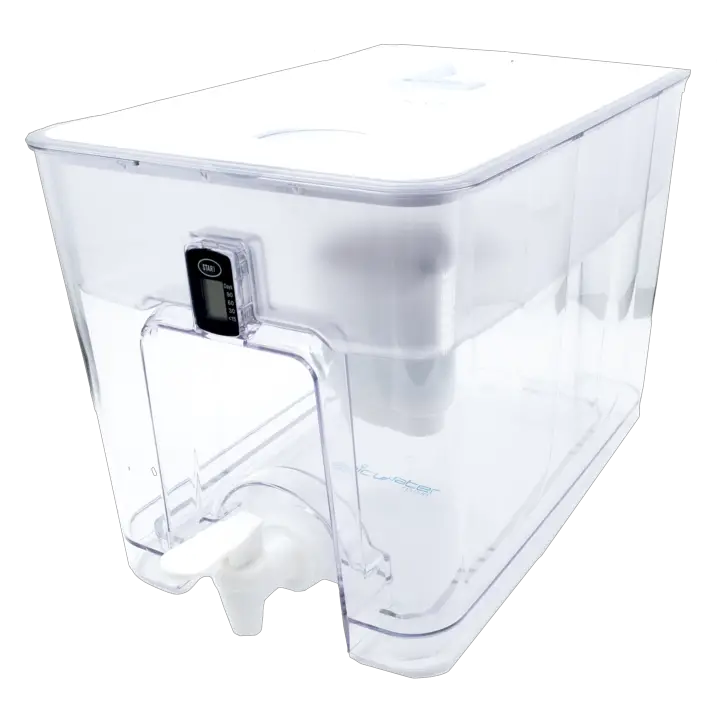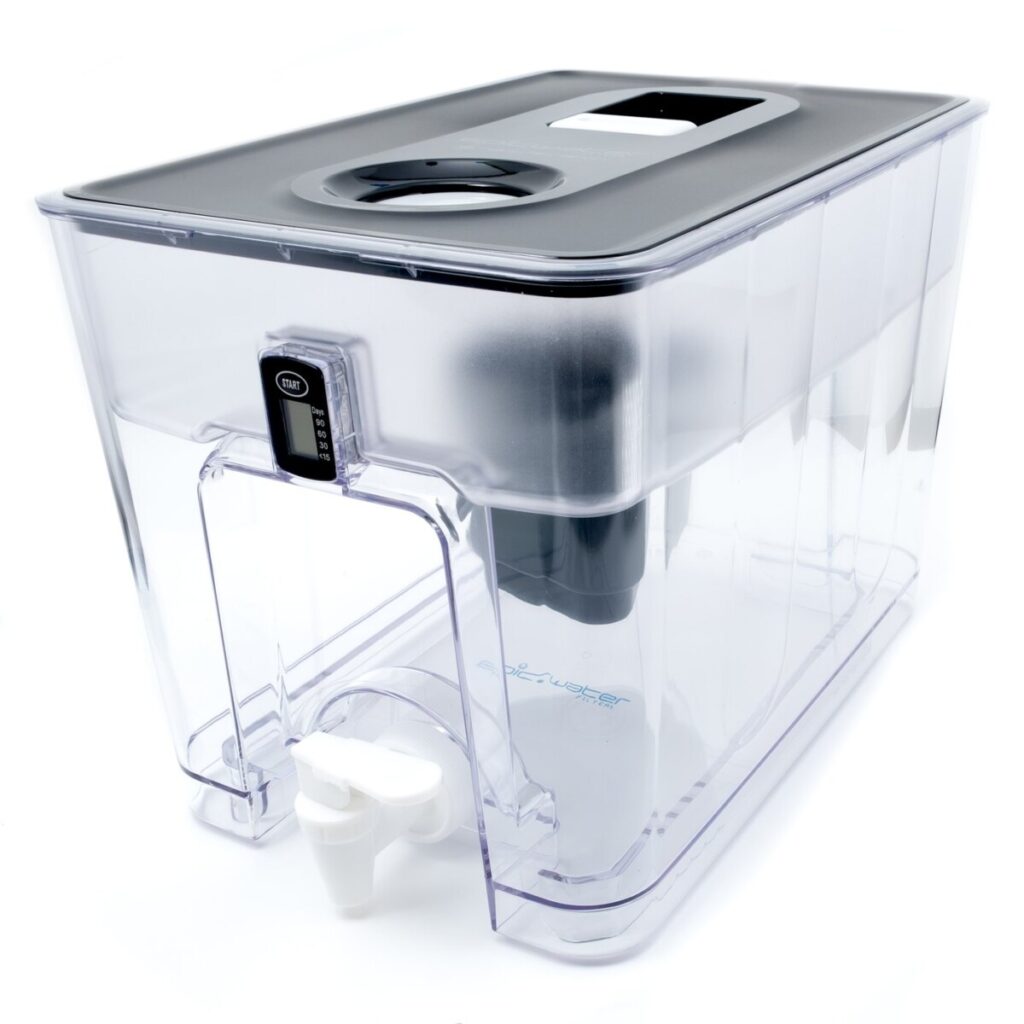Water filters that are effective at reducing the concentration of microplastics in water include reverse osmosis, nanofiltration, ultrafiltration, microfiltration, and activated carbon filtration.
Microplastics are found in 94 % of US tap water, and you are probably unknowingly consuming some on a regular basis. Very few filter brands actually state they can remove microplastics, and not all remove the smallest sized particles, but it’s easy to learn which ones do.
To give you a better idea on microplastics, I’ve put together a TON of information on which water filters are best at removing microplastics, including some specific brands, how small microplastics (and nanoplastics) actually are, and why they may be dangerous. If you want to know more, keep reading.
How to remove microplastics from water
The science behind reducing microplastics in water is fairly straightforward. Since microplastics are less than 5 mm long, using a filter that has a pore sizes on the micrometer (micron) scale will be capable of physically removing most microplastics from water.
A filter with a pore size less than 0.1 micrometers (0.0001 mm or 100 nm) is ideal for removing microplastics from water.
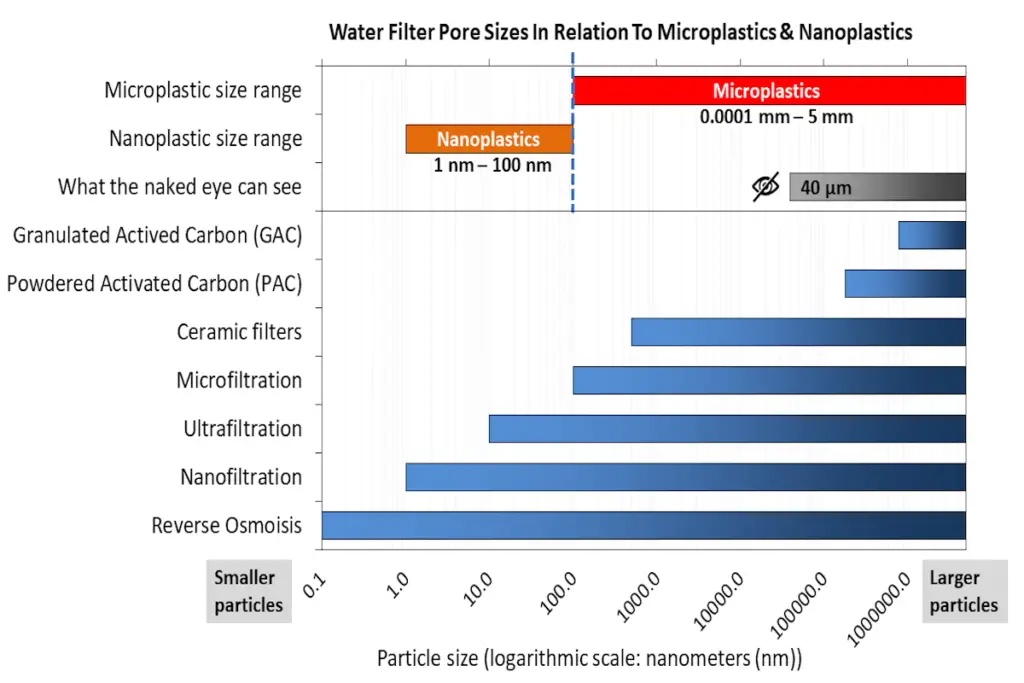
This graph shows the pore sizes of different filter types in relation to the size range of microplastics and nanoplastics. Grey bar shows what you can see with the naked eye. Longer blue bars indicate smaller plastic particles that can be removed by each filter type. Note the X-axis particle size is a logarithmic scale in nanometers. Created by Russell Singleton for waterpurificationguide.com
Keep in mind that few filter methods will remove ALL plastic particles from water as they can also exist as nanoplastics, which can be 100 times smaller than microplastics (EFSA 2016). Keep reading for more detail on these.
As you can see in the diagram above, most microplastics can be removed (or at least reduced) by four main filter processes – microfiltration, ultrafiltration, nanofiltration, and reverse osmosis.
Microfiltration
Microfiltration refers to passing an impure liquid through a semipermeable membrane with a pore size between 0.1 and 10 micrometers (or microns).
Since microplastics are larger than this dimension, microfiltration can be used to filter out most microplastics.
Ultrafiltration
Ultrafiltration uses the same principle as microfiltration, but the pores are even smaller – between 0.1 and 0.01 micrometers, making it a more effective and comprehensive way of reducing microplastics in water.
Nanofiltration
In nanofiltration, water is passed through a semipermeable filter membrane with a pore size of 0.001 micrometers, making it one of the most effective microplastics reducer.
Reverse Osmosis
Reverse osmosis (RO) is the best method to remove microplastics and nanoplastics from water because it employs a special mechanism of removal. In the case of reverse osmosis, the contaminated water is pushed through a semi-permeable membrane of pore size 0.0001 micrometers against its natural concentration gradient.
By forcing contaminated water from a region of higher impurity concentration to a region of lower impurity concentration, the impurities (in this case, microplastics and nanoplastics) stay on one side, while pure water is pushed to the other. RO filtration also desalinates and softens the water.
Therefore, any filter that uses one (or more) of these processes can remove microplastics and some nanoplatics.
Do carbon filters remove microplastics?
Carbon filters can reduce the concentration of microplastics in water by trapping them in the tiny pore spaces within the carbon media. This is a mechanical form of microplastic removal much like how a strainer can remove pasta from boiled water.
Microplastics can also contain pigments, polymer additives and other adsorbed contaminants, such as heavy metals (Oßmann et al., 2018), which may also get adsorbed (stuck) onto the carbon surface along with the associated plastic particles – effectively removing them from the water.
There are two main types of carbon filters used in water filtration – granular activated carbon (GAC) filters, and carbon block filters (containing powdered activated carbon (PAC) or a combination of both GAC and PAC).
Granular activated carbon
GAC used in drinking water filters typically have carbon particle sizes in the range of 0.8 to 1.0 mm (US 8 x 30 mesh size).
Another issue with GAC filters is water is prone to forming channels between the carbon particles. This allows for faster filter speeds but has the downside of letting more impurities, such as microplastics, get through.
GAC filters are incredibly successful at removing PFAS from water. Water Purification has more information on water filter pitchers that use this technology to remove PFAS available here.
Carbon block filters
Carbon block filters are denser than GAC filters. The powdered activated carbon filters generally have carbon particle sizes less than 0.18 mm (US 80 mesh size). While it takes more time for water to pass through a PAC carbon block filter, these filters are capable of removing smaller and more microplastics from water than GAC filters.
While both carbon filter types will remove some microplastic size fractions they are not as effective as microfiltration, ultrafiltration, nanofiltration, or reverse osmosis.
Does boiling water remove microplastics?
Boiling water does not remove microplastics as there is no physical filtration process involved. While boiling water destroys bacteria and other microorganisms, it is ineffective at removing microplastics.
Does distilling water remove microplastics?
In theory, distilling water should reduce the majority of microplastics in water because most suspended impurities are left behind in the distilling process. However, some microplastics (and nanoplastics) are fine enough to be suspended in the air, which means they may be carried with the evaporated water before condensing in the distillation water chamber.
Types of water filters that remove microplastics
Water filters have two types of pore grading – absolute and nominal.
Filters rated with an ‘absolute’ grade filter water more consistently than filters with a ‘nominal’ rating.
This means it’s best to use filters with an absolute rating to reduce microplastics in water.
In theory, any water filter that employs one of the methods listed above should reduce the concentration of microplastics. However, since microplastics are unregulated by the EPA, there is no standard.
- Refrigerator filters: Since fridge filters use activated carbon filter cartridges, they can effectively reduce the concentration of microplastics.
- Faucet filters: Faucet filters also use a carbon filter to purify water. Depending on the carbon pore size, they may reduce some microplastics in water.
- Ceramic filters: Ceramic filters use filters made of porous ceramic material. Water is poured over this filter to remove impurities and collected below. The pores in ceramic filters range between 0.5 and 0.25 micrometers which means that they can remove most microplastics.
- Under-the-sink filters: Most under-the-counter filters use reverse osmosis, which is very effective in reducing microplastics in water. Some under-the-sink filters use microfiltration, which also reduces microplastics in water.
10 Brands Of Water Filters That Remove Microplastics
Note that all of these filters have been tested to remove microplastics by the manufacturer. They are available from Clearlyfiltered.com, Epicwater.com, Amazon, and EcoWater.com.
1. Clearly Filtered Filter Pitcher
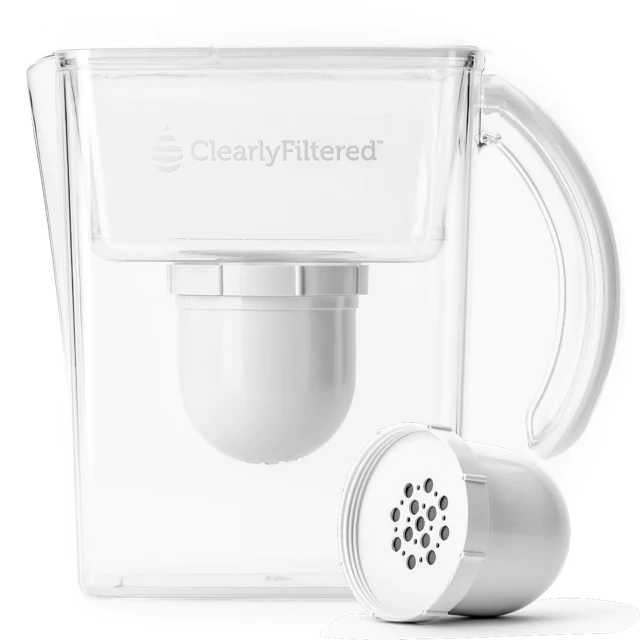
The Clearly Filtered Pitcher removes >99.9 % of microplastics from water – which is excellent! They use a proprietary filtration technology (called Affinity) that employs 7+ filtration materials and a stepped three-stage filtration process:
- Stage 1: A woven stainless steel mesh screen to keep larger particles from entering the filter.
- Stage 2: A coconut granular activated carbon (GAC) filter.
- Stage 3: Composite shell containing the Affinity technology (7+ filtration materials).
It is the only filter Pitcher that has been independently tested to NSF standards 42, 53, 244, 401 & 473 and has been shown to effectively remove 99.9% of 365+ harmful contaminants – including microplastics that you are likely drinking in regular unfiltered tap water.
You can purchase this pitcher direct from clearlyfiltered.com.
Price: USD 90.00
2. Epic Water Filter Pitchers
Epic Water Filter Pitchers are capable of removing over 99% of microplastics from water! Epic Water make two models of 10-cup filter pitchers; the Epic Nano and the Epic Pure.
EPIC NANO FILTER PITCHER
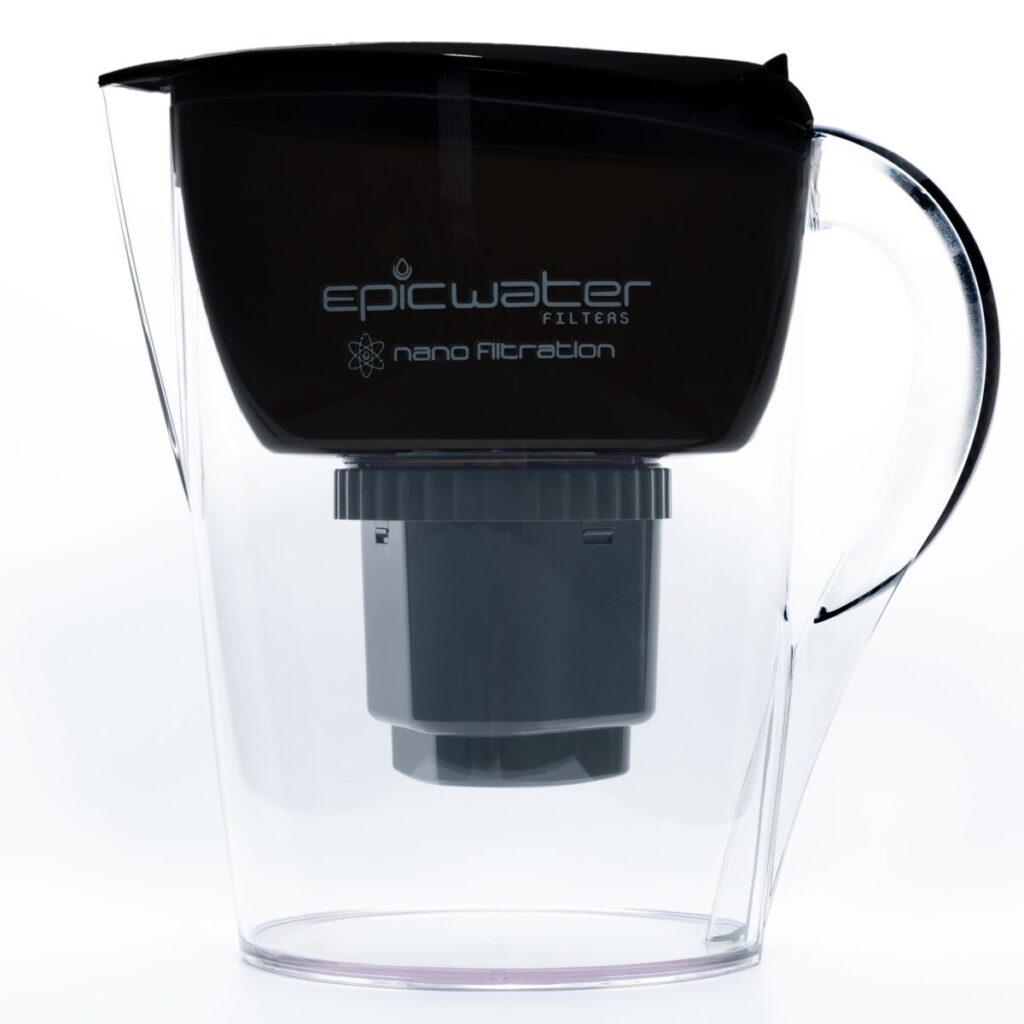
The Epic Nano Water filter pitcher removes 99.25% microplastics from water and 99.9999% of over 200+ other tap water contaminants, including viruses, bacteria, and cysts. This makes it perfect for well water or those that use tank water. The filter purifies around 150 gallons (565 L) of water and lasts around 3-4 months.
Analysis of the Epic Nano Water filter showed it exceeded the NSF/ANSI Standards 42, 53, 401, P473, & P23. It also offers a 99.4% lead reduction rate.
Buy now from EpicWater.
Price: USD 60.00.
EPIC PURE FILTER PITCHER
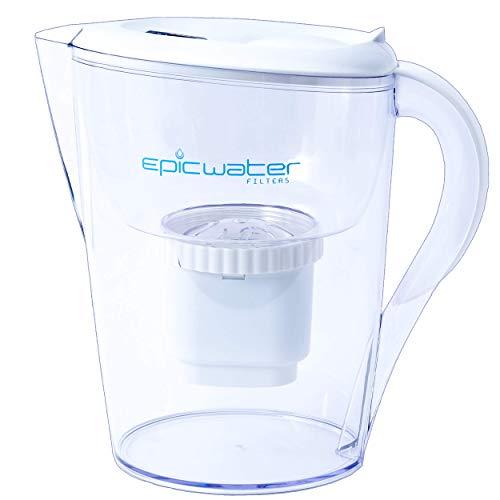
The Epic Pure water filter pitcher removes 99.62% of microplastic particles from water and 99.99% of all other tap water contaminant using two filtration mechanisms – ion exchange and activated carbon. This filter is NSF certified and comes with an LED timer to let you know when you should replace the filter – roughly 3-4 months (150 gallons).
You can purchase these from EpicWater here.
Price: USD 60.00
If you need something a little bigger, you can get these same great microplastic removing filters in a convenient 36-cup dispenser.
3. Epic Water Filter Bottles
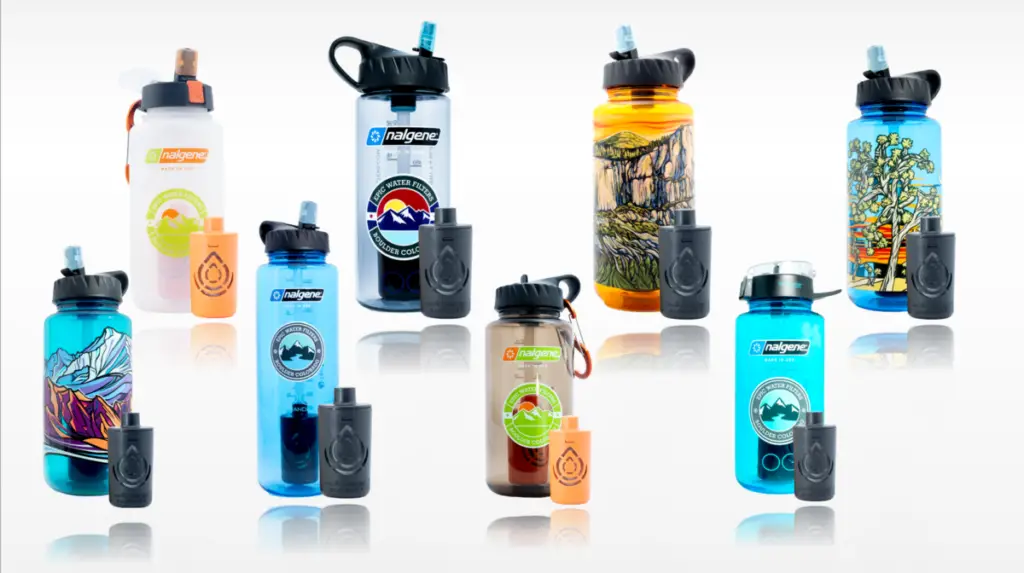
Epic Water Bottle Filters also remove over 99.25% of microplastics from water. The range of EpicWater bottles is awesome!
Price: USD $45.00 – $50.00
They come in many great designs and sizes and use the Everywhere Bottle Filter:
EVERYWHERE BOTTLE FILTER
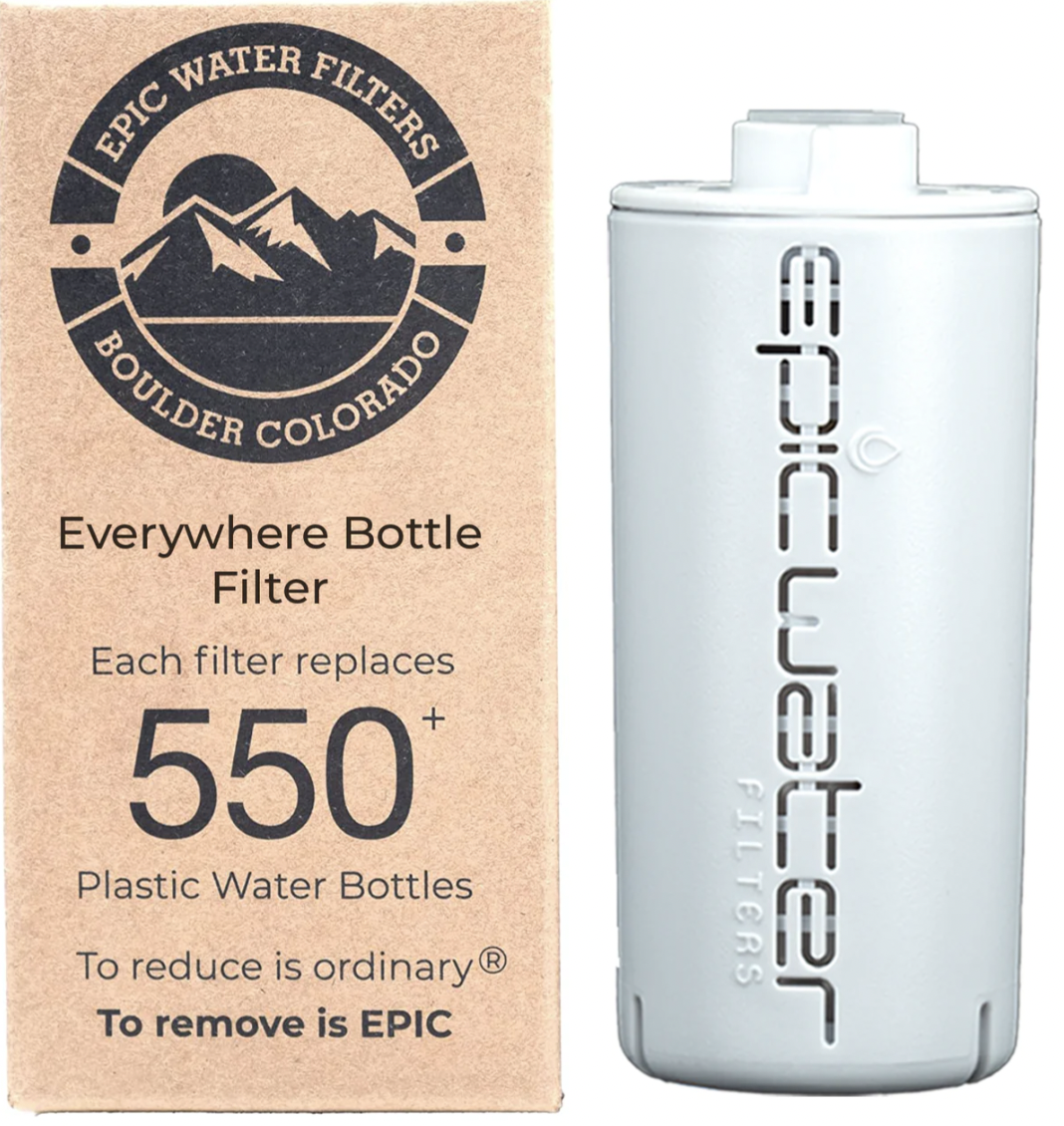
The Everywhere Bottle Filter is an urban tap water filter that removes 99.25% microplastics, and 99.99% of tap water and outdoor contaminants. The filters are made in the USA, are NSF certified, and fits all Epic bottle types. They filter ~75 gallons (285 liters) and can last 3-4 months.
Price: USD $30.00
4. FloWater Faucet Filter
This filter uses a coconut-based microfiltration system that reduces microplastics in water. The company claims the five-stage carbon block removes more than 95% of all microplastics larger than 2.0 micrometers (that’s 2,000 nanometers), but as with most filters, not all microplastics smaller than this size may be removed. It also filters more than 80 contaminants from water. The filter must be replaced every three months.
You can check out this filter on Amazon here.
Price: USD 99.00
5. LifeStraw Home Water Filter Pitcher
The LifeStraw Home Water Filter Pitcher uses a two-type filtration process to enable quick, efficient and effective filtration. The company claims that the LifeStraw membrane microfilter removes 99.999% of microplastics, bacteria, and other parasites with a pore size of 0.2 micron.
The LifeStraw activated carbon plus ion exchange filter removes lead, chlorine, pesticides, and other chemical contaminants. The membrane microfilter lasts up to one year, while the activated carbon filter must be replaced every two months. The conveniently shaped pitcher is easy to handle and pour.
You can buy this product on Amazon here.
Price: USD 39.99
6. Zerowater Filter Pitcher
This Zerowaterfilter pitcher uses a 5-stage filtration mechanism to reduce TDS, lead, and other contaminants. The ready-to-pour technology lets you dispense water as it filters which means that you don’t have to wait until the pitcher is full. Each fil This filter pitcher uses a 5-stage filtration mechanism to reduce TDS, lead, and other contaminants.
According to ZeroWater, all filters with the 5-stage Ion Exchange filtration system remove 99.9% of microplastics from tap water. The ready-to-pour technology lets you dispense water as it filters which means that you don’t have to wait until the pitcher is full. Each filter has a lifespan of 20 gallons.
Zerowater filter pitchers range from 10 cup round pitchers right up to a beautiful 40 cup glass dispenser.
Price: USD 32.99 – 75.00
7. ProOne Water Filters
The ProOne Traveler+ Water Filter makes use of gravity and GAC filtration mechanism to remove over 200 contaminants from water. They are capable of removing 99.999% of microplastics of two microns and above.
These stainless steel units are NSF ANSI certified and require no electricity to function. They are most suitable for family use.
Price – USD 209.95
8. Sawyer PointOneFilter
Sawyer PointOneFilters have a filter pore size of 0.1 microns which completely prevents harmful bacteria, protozoa, cysts, or microplastics from passing through.
In other words, the Sawyer standards claim that all Sawyer filters will remove 100% of microplastics from water. However, microplastics and nanoplastics can be much smaller than 0.1 microns, so in reality it can remove all microplastics larger than this.
On Amazon, you’ll find different sizes and styles of the Sawyer filters ranging from USD $19 – $100.
9. Survivor Filter Bottle
The Survivor Filter Bottle is the only product of Survivor filters that has been tested to remove 99.99% of microplastics from water.
It not only removes microplastics, but also heavy metals, toxic chemicals, parasites, and bacteria from water. You can get the Survivor Filter Bottle on Amazon.
Price – USD 40
What are microplastics, really?
Microplastics – it’s pretty much in the name.
Microplastics are small pieces of plastic with a length less than 5 millimeters (mm), that are non-biodegradable and polluting. Most microplastics are not visible to the naked eye.
These plastic pieces are formed as discarded polymers and plastics degrade over time. When plastics are disposed of irresponsibly (especially in the ocean), the polymers break down into smaller particles. Since plastics are non-biodegradable, the particles cannot decompose. Eventually, microplastics are formed.
The Great Pacific Garbage Patch, an island of plastic waste floating in the Pacific, is one of the major sources of microplastics in the ocean.
Microplastics may also find their way into the environment through sources less obvious than the Great Pacific Garbage Patch. From plastic water bottles, exfoliating microbeads commonly found in face wash, synthetic nylon clothing, and even from your takeaway paper coffee cups, microplastics are found everywhere.
Today, microplastics have become a serious threat to the environment. Microplastics have been found as far as Antarctica, and as deep as the Mariana Trench. They are also very pervasive – studies have shown that microplastics are found not only in water but also in the air we breathe. As marine organisms ingest water with microplastics, they may find their way into food as well.
How microplastics enter our drinking water
A study reported in Time magazine showed that microplastics are found in 83% of tap water worldwide. The United States tops the list at 94%. Research by Orb Media showed that 93% of the top 11 bottled water brands in the world contained microplastics (Mason, Welch, and Neratko, 2018).
But where are these microplastics coming from?
Microplastics are so pervasive that it is difficult to pinpoint a single source in the water supply.
Tap fittings may also leech microplastics in the drinking water supply. Synthetic fibers in the laundry may release microfibers in the water. Microbeads, found in makeup, skincare, and beauty supplies, also contribute to microplastics in water.
Even spring water and mountain water contain microplastics.
Since microplastic levels in water is unregulated by the U.S. EPA, there is no safe amount cap.
Why microplastics are harmful
Microplastics are pervasive and polluting but under-studied. There is not much research on the harm that microplastics may pose to humans because conducting these studies would require humans to be intentionally exposed to microplastics. But there are many reasons to believe that they may not be too good for us.
Microplastics are one of the culprits in killing sea life around the world, according to an article by The Guardian. Microplastics are not biodegradable, which means that they may accumulate in animals over time.
Fish that consume microplastics may die of starvation before reaching reproductive age. Microplastics may also accumulate in the bodies of humans that consume fish that consume microplastics, leading to a toxic bioaccumulation.
Another study found that hamsters injected with plastic particles were more susceptible to blood clots (Browne et al., 2015) . Plastics can also increase the concentration of protein and metals in cells, causing tissue inflammation and cell death.
Microplastics from microfibers may also be treated with chemicals and dyes, which when consumed, can cause allergic reactions. Besides, microplastics in the body may accumulate PCBs and BPAs, which cause adverse health effects.
What are the smallest microplastics?
Microplastics are any pieces of plastic less than 5 millimeters (mm) in length. The smallest MICROplastics are 0.1 micrometers (µm) in length – that’s one ten thousandth of one millimeter – and below this we start to get into the range of NANOplastics.
Nanoplastics range from 1 to 100 nanometers (nm) (EFSA 2016). To give you an idea of how small these are, 1 micrometer is equal to 1,000 nanometers.
To put this another way, a good reverse osmosis system will remove particles that are >0.0001 micrometers in size, which is equal to >0.1 nanometers. Again, this is why reverse osmosis is one of the best ways to remove microplastics (and nanoplastics) from water.
The naked eye can see particles 40 micrometers in size, so you can’t see the smaller sized microplastics or any nanoplastics in water.
How to reduce microplastics in the environment
While microplastics are not going away anytime soon, we can take a few steps to reduce contributing to the problem by following these steps:
- Limit your consumption of single-use plastics.
- Dispose of plastic waste responsibly, and DO NOT litter in water bodies.
- Pick up trash wherever you see it, especially in or near water bodies.
- Wash synthetic clothing less often and use a fiber filter in your washing machine.
- Do not dispose of dryer lint in the drain.
- Use a filter to remove microplastics from drinking water.
Research about microplastics and their impact on human health is ongoing. Meanwhile, finding the best filter for your water is the best way to prevent any adverse effects of not just microplastics, but any contaminant. Staying on top of your water game helps you stay healthy, hydrated, and smart!
References
Browne, M.A., Underwood, A.J., Chapman, M.G., Williams, R., Thompson, R.C. and van Franeker, J.A., 2015. Linking effects of anthropogenic debris to ecological impacts. Proceedings of the Royal Society B: Biological Sciences, 282(1807), p.20142929. <Linking effects of anthropogenic debris to ecological impacts (royalsocietypublishing.org)>
EFSA Panel on Contaminants in the Food Chain (CONTAM), 2016. Presence of microplastics and nanoplastics in food, with particular focus on seafood. Efsa Journal, 14(6), p.e04501. <Presence of microplastics and nanoplastics in food, with particular focus on seafood – – 2016 – EFSA Journal – Wiley Online Library>
Mason, S.A., Welch, V.G. and Neratko, J., 2018. Synthetic polymer contamination in bottled water. Frontiers in chemistry, 6, p.407. <Frontiers | Synthetic Polymer Contamination in Bottled Water | Chemistry (frontiersin.org)>
Oßmann, B.E., Sarau, G., Holtmannspötter, H., Pischetsrieder, M., Christiansen, S.H. and Dicke, W., 2018. Small-sized microplastics and pigmented particles in bottled mineral water. Water research, 141, pp.307-316. <Small-sized microplastics and pigmented particles in bottled mineral water (uswr.ac.ir)>
Ranjan, V.P., Joseph, A. and Goel, S., 2020. Microplastics and other harmful substances released from disposable paper cups into hot water. Journal of Hazardous Materials, 404, p.124118. <Microplastics and other harmful substances released from disposable paper cups into hot water – ScienceDirect>

